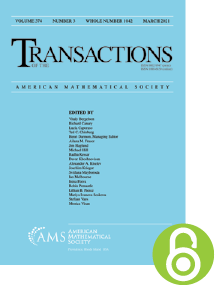Quantum symmetric states on free product $C^*$-algebras
HTML articles powered by AMS MathViewer
- by Kenneth J. Dykema, Claus Köstler and John D. Williams PDF
- Trans. Amer. Math. Soc. 369 (2017), 645-679 Request permission
Abstract:
We introduce symmetric states and quantum symmetric states on universal unital free product $C^*$-algebras of the form $\mathfrak {A}=\operatorname * {\ast }_1^\infty A$ for an arbitrary unital $C^*$-algebra $A$ as a generalization of the notions of exchangeable and quantum exchangeable random variables. We prove the existence of conditional expectations onto tail algebras in various settings and we define a natural $C^*$-subalgebra of the tail algebra, called the tail $C^*$-algebra. Extending and building on the proof of the noncommutative de Finetti theorem of Köstler and Speicher, we prove a de Finetti type theorem that characterizes quantum symmetric states in terms of amalgamated free products over the tail $C^*$-algebra, and we provide a convenient description of the set of all quantum symmetric states on $\mathfrak {A}$ in terms of $C^*$-algebras generated by homomorphic images of $A$ and the tail $C^*$-algebra. This description allows a characterization of the extreme quantum symmetric states. Similar results are proved for the subset of tracial quantum symmetric states, though in terms of von Neumann algebras and normal conditional expectations. The central quantum symmetric states are those for which the tail algebra is in the center of the von Neumann algebra, and we show that the central quantum symmetric states form a Choquet simplex whose extreme points are the free product states, while the tracial central quantum symmetric states form a Choquet simplex whose extreme points are the free product traces.References
- Beatriz Abadie and Ken Dykema, Unique ergodicity of free shifts and some other automorphisms of $C^\ast$-algebras, J. Operator Theory 61 (2009), no. 2, 279–294. MR 2501005
- Stephen Curran, Quantum exchangeable sequences of algebras, Indiana Univ. Math. J. 58 (2009), no. 3, 1097–1125. MR 2541360, DOI 10.1512/iumj.2009.58.3939
- Kenneth J. Dykema and Claus Köstler, Tail algebras of quantum exchangeable random variables, Proc. Amer. Math. Soc. 142 (2014), no. 11, 3853–3863. MR 3251725, DOI 10.1090/S0002-9939-2014-12116-2
- Rolf Gohm and Claus Köstler, Noncommutative independence from the braid group $\Bbb B_\infty$, Comm. Math. Phys. 289 (2009), no. 2, 435–482. MR 2506759, DOI 10.1007/s00220-008-0716-x
- Edwin Hewitt and Leonard J. Savage, Symmetric measures on Cartesian products, Trans. Amer. Math. Soc. 80 (1955), 470–501. MR 76206, DOI 10.1090/S0002-9947-1955-0076206-8
- Olav Kallenberg, Probabilistic symmetries and invariance principles, Probability and its Applications (New York), Springer, New York, 2005. MR 2161313
- Claus Köstler, A noncommutative extended de Finetti theorem, J. Funct. Anal. 258 (2010), no. 4, 1073–1120. MR 2565834, DOI 10.1016/j.jfa.2009.10.021
- Claus Köstler and Roland Speicher, A noncommutative de Finetti theorem: invariance under quantum permutations is equivalent to freeness with amalgamation, Comm. Math. Phys. 291 (2009), no. 2, 473–490. MR 2530168, DOI 10.1007/s00220-009-0802-8
- E. C. Lance, Hilbert $C^*$-modules, London Mathematical Society Lecture Note Series, vol. 210, Cambridge University Press, Cambridge, 1995. A toolkit for operator algebraists. MR 1325694, DOI 10.1017/CBO9780511526206
- Weihua Liu \nopunct. , private communication.
- Robert R. Phelps, Lectures on Choquet’s theorem, 2nd ed., Lecture Notes in Mathematics, vol. 1757, Springer-Verlag, Berlin, 2001. MR 1835574, DOI 10.1007/b76887
- Shôichirô Sakai, $C^*$-algebras and $W^*$-algebras, Ergebnisse der Mathematik und ihrer Grenzgebiete, Band 60, Springer-Verlag, New York-Heidelberg, 1971. MR 0442701
- Roland Speicher, Combinatorial theory of the free product with amalgamation and operator-valued free probability theory, Mem. Amer. Math. Soc. 132 (1998), no. 627, x+88. MR 1407898, DOI 10.1090/memo/0627
- Erling Størmer, Symmetric states of infinite tensor products of $C^{\ast }$-algebras, J. Functional Analysis 3 (1969), 48–68. MR 0241992, DOI 10.1016/0022-1236(69)90050-0
- Dan Voiculescu, Symmetries of some reduced free product $C^\ast$-algebras, Operator algebras and their connections with topology and ergodic theory (Buşteni, 1983) Lecture Notes in Math., vol. 1132, Springer, Berlin, 1985, pp. 556–588. MR 799593, DOI 10.1007/BFb0074909
- D. V. Voiculescu, K. J. Dykema, and A. Nica, Free random variables, CRM Monograph Series, vol. 1, American Mathematical Society, Providence, RI, 1992. A noncommutative probability approach to free products with applications to random matrices, operator algebras and harmonic analysis on free groups. MR 1217253, DOI 10.1090/crmm/001
- Shuzhou Wang, Quantum symmetry groups of finite spaces, Comm. Math. Phys. 195 (1998), no. 1, 195–211. MR 1637425, DOI 10.1007/s002200050385
Additional Information
- Kenneth J. Dykema
- Affiliation: Department of Mathematics, Texas A&M University, College Station, Texas 77843-3368
- MR Author ID: 332369
- Email: kdykema@math.tamu.edu
- Claus Köstler
- Affiliation: School of Mathematical Sciences, Western Gateway Building, Western Road, University College Cork, Cork, Ireland
- MR Author ID: 639717
- Email: claus@ucc.ie
- John D. Williams
- Affiliation: Department of Mathematics, Fachrichtung Mathematik, Universität des Saarlandes, Campus E24, 66123 Saarbrücken, Germany
- MR Author ID: 1004929
- Email: williams@math.uni-sb.de
- Received by editor(s): June 25, 2013
- Received by editor(s) in revised form: September 24, 2014, and January 17, 2015
- Published electronically: March 21, 2016
- Additional Notes: The first author was supported in part by NSF grant DMS-1202660.
The second author was supported in part by EPSRC grant EP/H016708/1. - © Copyright 2016 American Mathematical Society
- Journal: Trans. Amer. Math. Soc. 369 (2017), 645-679
- MSC (2010): Primary 46L53; Secondary 46L54, 81S25, 46L10
- DOI: https://doi.org/10.1090/tran6661
- MathSciNet review: 3557789


